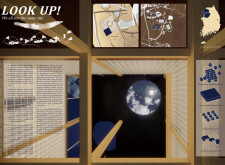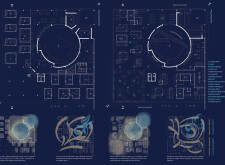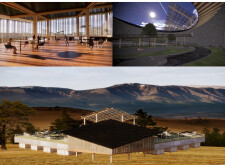5 key facts about this project
### Project Overview
Located in Yeongyang-gun, South Korea, the architectural design seeks to create a functional workspace that aligns with the natural landscape while fostering community interaction and individual productivity. The design philosophy is informed by the concept encapsulated in the title, **"LOOK UP! We all see the same sky,"** which emphasizes a connection to nature and the surrounding community. The choice of site is deliberate, aiming to respond to the ecological attributes of the mountainous region and to the needs of a population increasingly affected by urban density.
### Spatial Organization and User Experience
The design employs a modular and decentralized approach, resulting in flexible workstations that accommodate diverse working styles ranging from solitary focus to collaborative engagement. Floor plans are carefully organized to balance communal and private spaces, with central areas such as dining and meeting rooms intentionally positioned to encourage interaction while allowing for personal space. Large glass facades and circular skylights facilitate abundant natural light and unobstructed views, enhancing users’ emotional well-being and maintaining a vital connection to the outdoors. Outdoor engagement is further promoted through features like rooftop gardens and courtyards, creating inviting extensions of the workspace.
### Material Selection and Sustainability
The project's material palette is selected for its aesthetic qualities and environmental benefits. Wood serves as the primary material for structural components and finishes, contributing to sustainability and creating a warm interior atmosphere. Expanses of glass bridge the divide between interior and exterior spaces, optimizing light and enhancing views. Concrete provides stability and durability in structural elements, while steel is integrated into modular components for added architectural expression. Textile materials in furnishings introduce comfort and support acoustic control in communal areas. This thoughtful use of materials not only emphasizes sustainability but also reflects the site’s natural character and its community’s ethos.





















































